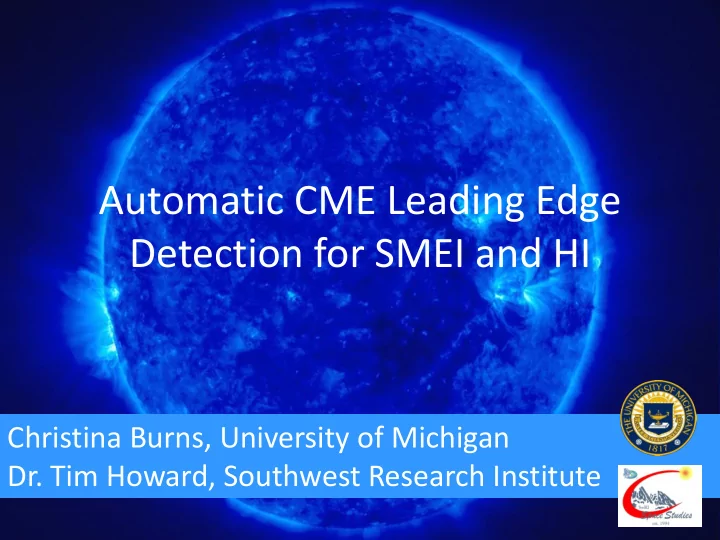

Automatic CME Leading Edge Detection for SMEI and HI Christina Burns, University of Michigan Dr. Tim Howard, Southwest Research Institute
Coronal Mass Ejections (CMEs) • Large magnetic plasma bubbles that are ejected from the sun over several hours • Often associated with solar flares or prominences • Can cause storms bringing huge problems to us on Earth • Typical speed: 500-1000 km/s • 1-5 days to impact Earth
LASCO C2 (Nov. 22 - 28, 2000)
February 2000 Leading Edge
Process • Created two programs to automatically detect the leading edge of a CME: – CLEDS: SMEI version – CLEDHI: HI version HI (RAL) SMEI (AFRL)
Why Was This Needed? • Automatically detecting the leading edge of the CME with a program eliminates human error • Automated, so able to run the program fast • Results are fed to the Tappin-Howard (TH) model to form a reconstruction of the CME • Ultimately provides a forecast for CME impact on Earth with an accuracy of +/- 5 hour
Method for Finding CMEs: Hough Transform • Both versions used this concept to find CMEs • Used as a mathematical image processing tool • Picks out straight lines from images and calls them CMEs • Very accurate at finding CMEs
Hough Transform Process Original image Transform to containing CME Hough space in elongation vs. time Apply masking Final image and filters transforming back to original coordinates
Solar Mass Ejection Imager (SMEI) • Aboard the Coriolis spacecraft – Polar orbit around Earth • SMEI directed toward Sun • Creates a whole-sky image as an Aitoff projection every 101 minutes • Sun is in the middle • Earth is at 90 degrees
SMEI Coordinates • Whole sky projection with Sun at center • Position Angle (PA) ranges 0 o to 360 o Sun Earth Line PA EA
SMEI Movie May 2003 Can you spot the CME(s)?
Detecting all of the CME
Detecting Just the Leading Edge
Leading Edge 2003 149 10:45 2003 149 10:45
Noise Gaps • SMEI images are 2003 149 10:45 VERY noisy • Noise gaps are crucial for correct detection of CMEs • Some CMEs could be hiding behind the noise and we wouldn’t know it
Heliospheric Imager (HI) • Onboard the STEREO A and STEREO B spacecrafts • Using the HI is beneficial because you can see what the CME does after takeoff, enabling a better space weather prediction HI (RAL) As of August 2, 2011 22 UT
SECCHI • HI is part of the Sun Earth Connection Coronal and Heliospheric Investigation (SECCHI) suite
CME as Seen by SECCHI
STEREO HI-2A Coordinates • PAs only range from 30 o to 150 o , not 0 o to 360 o • The sun is not in the center of the image PA EA SUN
STEREO HI-2A Dec 2008
CME Detection With STEREO HI-2A • The CLEDHI program could identify CMEs using the same method as CLEDS • It identified the feature shown in HI-2A movie on December 12, 2008 • Only tried with STEREO HI-2A data for now – STEREO B is blurry
Tappin-Howard (TH) Model • TH model takes the CLED outputs of the CME leading edge and noise gaps as inputs • Compares the measured leading edge data with those from simulated CMEs to create an estimation of CME geometry and kinematics • All done automatically
Reconstruction of May 2003 CME
STEREO HI-2A February 16, 2011 (Valentine’s Day Storm) CME Venus Earth
Real-Time Predictions for the Valentine’s Day Storm
TH Model Best Prediction Dec 2004
Conclusion • Using heliospheric imagers to make a CME impact prediction can produce more accurate results because it is possible to see how the CME might change over time • We have produced programs to automatically detect the leading edge of a CME and the noise gaps associated with SMEI images to feed to a CME prediction model • Automating the prediction makes it possible to create many predictions over a short period of time
Acknowledgements • Dr. Tim Howard, SwRI • Dr. Marty Snow and Erin Wood, LASP • Max Hampson, LASP • Robin Thompson, University of Oxford • REU Program and NSF • All of my fellow colleagues!
Recommend
More recommend